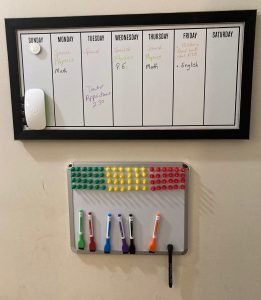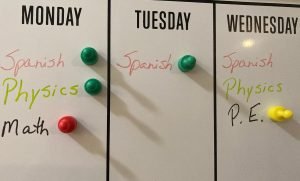Last year, we tried a Kanban board that was created with tape and post-it notes. You can read about it here. My oldest, now in college, really loved the Kanban with post-it notes and is now using that method on their own to keep up with their assignments, chores, and personal care. Unfortunately, this method didn’t resonate with my other kids, so we went back to the drawing board and created another solution.
This new method is also based on my husband’s industrial engineering work. He has used this method to track what is and isn’t working in manufacturing and processing plants with several companies over the years. So, it probably will work for helping a middle schooler stay organized, right?
The Set-Up
 This is a two-part system made up of a whiteboard, and a set of magnets. There are probably many ways to set up a system like this and test it out. However, I’m going to just describe what we are doing.
This is a two-part system made up of a whiteboard, and a set of magnets. There are probably many ways to set up a system like this and test it out. However, I’m going to just describe what we are doing.
We got a weekly dry erase board that is magnetic and put it in our hallway. It has the days of the week clearly across the top, with room to write assignments on each day. We then added a small second whiteboard that holds dry erase markers, and pawn magnets in green, red, and yellow. I like the pawn magnets because they are easier to grab than flat ones.
How it Works
Each day of the week, I will write up a list of assignments, or even just subject areas, and chores my child should do. When a task is completed, he puts a green magnet beside it. If he starts a task but doesn’t finish it, the task gets a yellow magnet. If the task doesn’t get done at all, it gets a red magnet.
 This is a very simple tracking system that will let us all see at a glance if the school plans for the day got done. While I’d love to see all green pawns each day, I know that isn’t reasonable. We all have bad days. Our current plan is to be able to take anything from the week that gets a red or yellow pawn and complete it on the weekend. My son would rather not do school work on the weekend, so he should be motivated to get all green. I’m very flexible, so if he wants to work on turning a red or yellow dot green during the week, that’s allowed. All I care about is that the work gets done.
This is a very simple tracking system that will let us all see at a glance if the school plans for the day got done. While I’d love to see all green pawns each day, I know that isn’t reasonable. We all have bad days. Our current plan is to be able to take anything from the week that gets a red or yellow pawn and complete it on the weekend. My son would rather not do school work on the weekend, so he should be motivated to get all green. I’m very flexible, so if he wants to work on turning a red or yellow dot green during the week, that’s allowed. All I care about is that the work gets done.
Hope Springs Eternal
Another goal with this method is to help my student see what he has accomplished each week. This visual feedback of both creating a list of assignments and marking them as completed or not should help him have more ownership of his education. If he just completes the assignments I give out, he doesn’t always register how much work he’s done.
One thing I really love about this as an OT is that he gets to move the magnets and check off his work himself. Moving the magnets seems more satisfying than just writing a checkmark. That sense of satisfaction is what I want to cultivate, so we invested in the magnets. Having a checklist is meaningless if no one wants to use it. So, we will be using lots of colorful markers and magnets to make this a system we all enjoy. Enjoying it will mean we use it.
And if it doesn’t really work, we’ll try something else. By the time these kids get out of high school, they might be able to pass a Six Sigma exam…. But we are going to get organized. Period.





For anyone wondering how this worked, we added a money component to this system and it worked really well. We paid an amount per green dot, took away half the value of a green for each red dot, and yellow dots did not affect his allowance. At the time, the kid was money motivated and it worked really well.